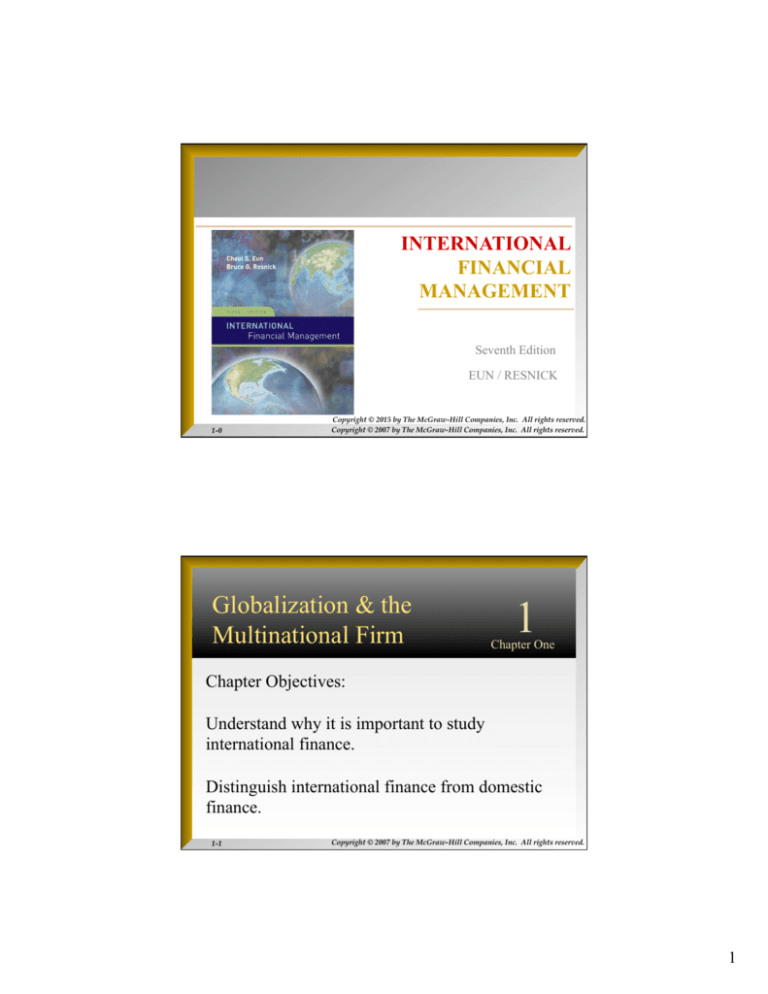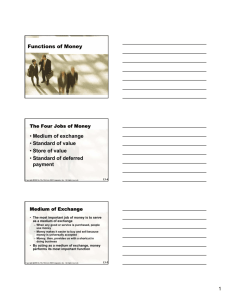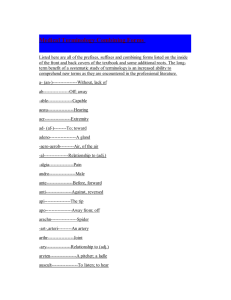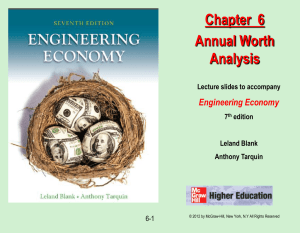
INTERNATIONAL
FINANCIAL
MANAGEMENT
Seventh Edition
EUN / RESNICK
1-0
Copyright © 2015 by The McGraw-Hill Companies, Inc. All rights reserved.
Copyright © 2007 by The McGraw-Hill Companies, Inc. All rights reserved.
Globalization & the
Multinational Firm
1
Chapter One
Chapter Objectives:
Understand why it is important to study
international finance.
Distinguish international finance from domestic
finance.
1-1
Copyright © 2007 by The McGraw-Hill Companies, Inc. All rights reserved.
1
Chapter One Outline
l
What’s Special about “International” Finance?
l
Goals for International Financial Management
l
Globalization of the World Economy
l
Multinational Corporations
l
Organization of the Course
l
Summary
Copyright © 2007 by The McGraw-Hill Companies, Inc. All rights reserved.
1-2
What’s Special about
“International” Finance?
l
Nations are sovereign & set their own policies ->
l
1. Foreign Exchange Risk
l
2. Political Risk
l
3. Market Imperfections
l
4. Expanded Opportunity Set
1-3
Copyright © 2007 by The McGraw-Hill Companies, Inc. All rights reserved.
2
What’s Special about
“International” Finance?
l
1. Foreign Exchange Risk
n
The risk that foreign currency profits may evaporate in
home-currency terms due to unanticipated/unfavorable
exchange rate movements:
u
A year ago, a US investor bought 120 shares of Toyota at
¥10,000 per share (worth ¥ 1.2m)
n the FX rate was $1 = ¥100 à her dollar cost was $12,000
u
Now, a year later, suppose that her investment is worth 10%
more in Yen: ¥1,320,000
n However, because the yen has depreciated to $1 = ¥119 this U.S.
investor has actually lost money in dollar terms:
¥1,320,000 / 119¥/$ = $11,092 < $ 12,000
Copyright © 2007 by The McGraw-Hill Companies, Inc. All rights reserved.
1-4
What’s Special about
“International” Finance?
l
2. Political Risk
n
n
Sovereign governments have the right to regulate the
movement of goods, capital, and people across their
borders.
These laws (or their enforcement) sometimes change in
unexpected ways.
u Thai
government curbs on “speculators”, Dec.’06
u Zimbabwe’s decision re: local ownership of firms, March’08
u Venezuelan (’09)/Russian (’14) actions vs. foreign food firms
u Short sales limits in US-UK-OZ (‘08) & Germany (’10); U.S.
tax lawsuits; Spanish & French majority-voting laws (’13)
1-5
Copyright © 2007 by The McGraw-Hill Companies, Inc. All rights reserved.
3
What’s Special?
l
l
2a. Operational Risk:
Risk Briefing rates
operational risk in 150
markets on a scale of 0-100.
The overall scores are an
aggregate of underlying
scores for ten categories of
risk: security; political
stability; government
effectiveness; legal and
regulatory; macroeconomic;
foreign trade and payments;
financial; tax policy; labor
market; and infrastructure.
The model is run when
events require it, and at least
once a quarter for each
country.
1-6
Copyright © 2007 by The McGraw-Hill Companies, Inc. All rights reserved.
What’s Special?
l
2b.
Political
Stability:
1-7
Copyright © 2007 by The McGraw-Hill Companies, Inc. All rights reserved.
4
What’s Special about
“International” Finance?
l
3. Market Imperfections
n Legal
restrictions on movement of goods,
people, and money
n Transactions
n Shipping
n Tax
1-8
costs
costs
arbitrage
Copyright © 2007 by The McGraw-Hill Companies, Inc. All rights reserved.
Market Imperfections & Political Risk :
The Example of Nestlé
l
Nestlé used to issue two different classes of
common stock (bearer shares & registered shares).
Foreigners were only allowed to buy bearer shares.
n Swiss citizens alone could buy registered shares.
n The bearer stock was more expensive. (why?)
n
On November 18, 1988, Nestlé lifted restrictions
imposed on foreigners, allowing them to hold
registered shares as well as bearer shares
l What do you think happened?
l
1-9
Copyright © 2007 by The McGraw-Hill Companies, Inc. All rights reserved.
5
Nestlé’s Foreign Ownership Restrictions
12,000
10,000
Bearer share
SF
8,000
6,000
4,000
Registered share
2,000
0
11
20
31
9
18
24
Source: Financial Times, November 26, 1988 p.1. Adapted with permission.
1-10
Copyright © 2007 by The McGraw-Hill Companies, Inc. All rights reserved.
The Example of Nestlé (continued)
l
Following this, the price spread between the two
types of shares narrowed dramatically.
n
l
Foreigners holding Nestlé bearer shares
n
l
This implies that there was a major transfer of wealth
from foreign shareholders to Swiss shareholders.
Exposed to political risk in a country that is (was?)
widely viewed as a haven from such risk.
The Nestlé episode illustrates
The importance of market imperfections
n The peril of political risk.
n
1-11
Copyright © 2007 by The McGraw-Hill Companies, Inc. All rights reserved.
6
What’s Special about
“International” Finance?
l
4. Expanded Opportunity Set
n It doesn’t make sense to play in only one corner
of the sandbox.
n True for
u Corporations:
n
n
n
u Individual
investors: diversify risk
Copyright © 2007 by The McGraw-Hill Companies, Inc. All rights reserved.
1-12
What’s Special about
“International” Finance?
l
4. Expanded Opportunity Set
n It doesn’t make sense to play in only one corner
of the sandbox.
n True for
u Corporations:
n source inputs and sell outputs where it maximizes profits
n
n
u Individual
1-13
investors: diversify risk
Copyright © 2007 by The McGraw-Hill Companies, Inc. All rights reserved.
7
What’s Special about
“International” Finance?
l
4. Expanded Opportunity Set
n It doesn’t make sense to play in only one corner
of the sandbox.
n True for
u Corporations:
n source inputs and sell outputs where it maximizes profits
n reduce operational risk
n
u Individual
investors: diversify risk
Copyright © 2007 by The McGraw-Hill Companies, Inc. All rights reserved.
1-14
What’s Special about
“International” Finance?
l
4. Expanded Opportunity Set
n It doesn’t make sense to play in only one corner
of the sandbox.
n True for
u Corporations:
n source inputs and sell outputs where it maximizes profits
n reduce operational risk
n minimize financing costs
u Individual
1-15
investors: grow returns & diversify risk
Copyright © 2007 by The McGraw-Hill Companies, Inc. All rights reserved.
8
Goals for this Course
l
The focus of the course is to equip students with
the “intellectual toolbox” of an effective global
manager—but what goal should this effective
global manager be working toward?
n
Maximization of shareholder wealth?
or
n
Other Goals?
Copyright © 2007 by The McGraw-Hill Companies, Inc. All rights reserved.
1-16
Maximize Shareholder Wealth
l
Long accepted as a goal in the Anglo-Saxon
countries, but:
n
Worries exist about investors’ ST horizons
u Jack
Welch (FT March 2009) – “oxymoron”
u Warren Buffett – “ST investors = traders, not investors”
u “sustainable value” folks
n
Even in US/UK/OZ, complications arise:
u Who
/ where are the shareholders?
u In what currency should managers maximize shareholders’
wealth?
1-17
Copyright © 2007 by The McGraw-Hill Companies, Inc. All rights reserved.
9
Other Goals
l
In other countries, shareholders are viewed as
merely one among many “stakeholders” of the
firm including:
n
n
n
l
Employees
Suppliers
Customers
In Japan, managers have typically sought to
maximize the value of the keiretsu—a family of
firms to which the individual firms belongs.
1-18
Copyright © 2007 by The McGraw-Hill Companies, Inc. All rights reserved.
Other Goals
As shown by a series of corporate scandals at
companies (e.g., Enron, WorldCom, Refco,
Parmalat, Olympus, etc.), top managers may
pursue their own private interests at the expense of
shareholders when they are not closely monitored.
l These episodes highlight the importance of
corporate governance, i.e., the financial and legal
framework for regulating the relationship between
a firm’s management and its shareholders.
l
1-19
Copyright © 2007 by The McGraw-Hill Companies, Inc. All rights reserved.
10
Other Goals
These types of issues can be much more serious in
many other parts of the world, especially emerging
and transitional economies, such as Venezuela and
Russia (or even Thailand), where legal protection
of shareholders is weak or virtually non-existant.
l No matter what the other goals, they may not be
achieved in the long term if the maximization of
(long-term) shareholder wealth is not given due
consideration.
l
1-20
Copyright © 2007 by The McGraw-Hill Companies, Inc. All rights reserved.
Globalization of the World Economy:
Recent Trends
Emergence of Globalized Financial Markets
l Advent of the Euro
l Trade Liberalization & Economic Integration
l Privatization
l
1-21
Copyright © 2007 by The McGraw-Hill Companies, Inc. All rights reserved.
11
Emergence of Globalized
Financial Markets
l
l
Deregulation of Financial Markets (including “capital
account liberalization” in many emerging markets)
+ Advances in Technology
= Greatly reduced information & transactions costs,
àwhich has led to:
Financial Innovations, such as
n
n
n
n
1-22
Currency futures and options
Multi-currency bonds
Cross-border stock listings
Hedge Funds, International mutual funds
Copyright © 2007 by The McGraw-Hill Companies, Inc. All rights reserved.
Advent of the Euro
A momentous event in the history of world
financial systems.
l Currently Europeans in 19 countries use the
common currency on a daily basis.
l Up to 13 more countries that have joined or want
to join the EU may adopt the euro (Denmark is
l
currently in ERM II, 4 more may join)
l
If the Euro survives, its “transaction domain” may
become larger than the USD’s in the near future.
1-23
Copyright © 2007 by The McGraw-Hill Companies, Inc. All rights reserved.
12
Euro Area
23 Countries “participating” in the euro:
l
l
l
l
l
l
l
l
l
l
l
l
l
Austria
Belgium
Cyprus
Czech Republic
Denmark
#17 = Estonia
Finland
France
Germany
Greece
Hungary
Ireland
Italy
l
l
l
l
l
l
l
l
l
l
l
l
1-24
#18 = Latvia
#19 = Lithuania
Luxembourg
Malta
Netherlands
Poland
Portugal
#16 = Slovakia
Slovenia
Spain
Sweden
UK
Copyright © 2007 by The McGraw-Hill Companies, Inc. All rights reserved.
Euro Area
l
l
l
l
ERM II
Unilaterally
adopted
Other EU
members
Eurozone
1-25
Copyright © 2007 by The McGraw-Hill Companies, Inc. All rights reserved.
13
Value of the Euro in U.S. Dollars
January 1999 to 2015: Ups & Downs…
1-26
Copyright © 2007 by The McGraw-Hill Companies, Inc. All rights reserved.
Value of the US Dollar in Yen
1999 to 2015: an even wilder ride?
1-27
Copyright © 2007 by The McGraw-Hill Companies, Inc. All rights reserved.
14
Economic Integration
l
l
l
Over the past 50 years, international trade
increased about twice as fast as world GDP.
There has been a sea change in the attitudes of
many of the world’s governments who have
abandoned mercantilist views and embraced free
trade as the surest route to prosperity for their
citizenry.
With the current crisis, will this last?
n
1-28
Protectionism? Trade credit availability?
Copyright © 2007 by The McGraw-Hill Companies, Inc. All rights reserved.
Liberalization of
Protectionist Legislation
l
l
The General Agreement on Tariffs and Trade
(GATT) a multilateral agreement among member
countries has reduced many barriers to trade.
The World Trade Organization has the power to
enforce the rules of international trade.
n
l
Example: U.S. vs. Antigua – what can the latter do?
On January 1, 2005 the end of the era of quotas on
imported textiles ended.
1-29
Copyright © 2007 by The McGraw-Hill Companies, Inc. All rights reserved.
15
NAFTA
The North American Free Trade Agreement
(NAFTA) called for phasing out impediments to
trade between Canada, Mexico and the United
States over a 15-year period. Almost there!
l For Mexico, the ratio of export to GDP increased
dramatically – from 2.2% in 1973 to 28.7% in
2001 (to more than 30% today – why?)
l In theory, the increased trade should result in
increased numbers of jobs and a higher standard
of living for all member nations.
l
1-30
Copyright © 2007 by The McGraw-Hill Companies, Inc. All rights reserved.
Privatization
l
l
l
l
The selling off state-run enterprises to investors is
also known as “Denationalization”.
Often seen in socialist economies in transition to
market economies.
By most estimates this increases the efficiency of
the enterprise.
Often spurs a tremendous increase in cross-border
investment.
1-31
Copyright © 2007 by The McGraw-Hill Companies, Inc. All rights reserved.
16
Multinational Corporations
l
l
l
Definition: a firm that has incorporated in one
country and has production and sales operations
in other countries.
There are about 60,000 MNCs in the world.
Many MNCs obtain raw materials from one
nation, financial capital from another, produce
goods with labor and capital equipment in a third
country and sell their output in various other
national markets.
Copyright © 2007 by The McGraw-Hill Companies, Inc. All rights reserved.
1-32
Top 10 non-financial MNCs
(2013 = latest data, ranked by foreign assets)
1
2
3
4
5
6
7
8
9
10
1-33
General Electric Co
Royal Dutch Shell plc
BP plc
Toyota Motor Corporation
Total SA
Exxon Mobil Corporation
Vodafone Group Plc
GDF Suez
Chevron Corporation
Volkswagen Group
United States
United Kingdom
United Kingdom
Japan
France
United States
United Kingdom
France
United States
Germany
Copyright © 2007 by The McGraw-Hill Companies, Inc. All rights reserved.
17
Top 10 non-financial MNCs
l
l
Rankings are typically fairly stable.
The last few years have been anything but typical
l General Motors dropped from the top 10
l
l
Surprise…
Ranked by sales, the top 5 have generally been
oil companies
l since 2006…
Copyright © 2007 by The McGraw-Hill Companies, Inc. All rights reserved.
1-34
The Organization of this Course
Part III Chapters 9,8;
ATA, Chapter 10
World Financial
Markets and
Institutions
Part I Chapters 5,
7, 14; Supplements
ATA: Chapters
11-12-13
Macroeconomic
Environment
Where do FX
rates come
from?
Part II Chapters 3,2,6
Foreign
Exchange
Exposure and
Management
Financial
Management of
the MNC
Part IV Chapters 17-18
1-35
Copyright © 2007 by The McGraw-Hill Companies, Inc. All rights reserved.
18
End Chapter One
1-36
Copyright © 2007 by The McGraw-Hill Companies, Inc. All rights reserved.
19







